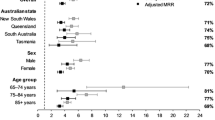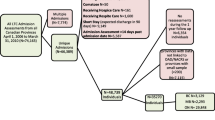Abstract.
Fracture prevention strategies will be most cost-effective if targeted on groups of frail elderly people who are at particularly high risk of falls and fractures. Elderly people living in care homes are one potential target population, but fracture incidence in this setting remains poorly defined in many countries. We used the All Wales Injury Surveillance System (AWISS) in a population-based study of people aged over 65 years living in the city of Cardiff. We linked a postcode-based register of all sheltered accommodation and all residential and nursing homes in the city with injury data from Cardiff's single Accident and Emergency Department. Cardiff has 47,700 residents aged over 65 years with 1918 (4.0%) living in residential or nursing homes and 1868 (3.9%) in sheltered accommodation. In 1999 we identified a total of 1305 fractures including 366 hip fractures, giving a crude fracture incidence of 27.4/1000 per year and 7.7/1000 per year, respectively. Care home residents suffered 213 fractures, 95 of which were of the hip, giving a crude fracture incidence of 111.1/1000 per year and 49.5/1000 per year, respectively. People living in sheltered accommodation suffered 94 fractures, including 28 at the hip, giving a crude fracture incidence of 51.4/1000 per year and 15.3/1000 per year, respectively. People in care homes and sheltered accommodation tend to be older than those living in the community, and we adjusted for this by calculating age- and gender-standardized relative ratios for each setting. Compared with the community dwelling population, care home residents had an overall fracture risk of 2.9 (95% CI 2.5–3.3) and a hip fracture risk of 3.3 (95% CI 2.6–4.2). People in sheltered accommodation had a total fracture risk of 1.7 (95% CI 1.4–2.1), and a hip fracture risk of 1.6 (95% CI 1.1–2.4). Such figures support the potential cost-effectiveness of strategies that seek to prevent fractures in care homes and sheltered accommodation, and are of special interest to those planning intervention studies in these settings.



Similar content being viewed by others
References
Lauritzen JB, Petersen MM, Lund B (1993) Effect of external hip protectors on hip fractures. Lancet 341:11–13
Chapuy MC, Arlot ME, Duboef F, Brun J, Couzet B, Arnaud S, Delmas PD, Meunier PJ (1992) Vitamin D3 and calcium to prevent hip fractures in elderly women. N Engl J Med 327:1637–1642
Chapuy MC, Arlot ME, Delmas PD, Meunier PJ (1994) Effect of calcium and cholecalciferol treatment for three years on hip fractures in elderly women. Br Med J 308:1081–1082
Johansen A, Evans R, Stone MD, Richmond P, Lo SV, Woodhouse KW (1997) The incidence of fracture in the United Kingdom: a study based on the population of Cardiff. Injury 28:655–660
Dolan P, Torgerson DJ (1998) The cost of treating osteoporotic fractures in the United Kingdom female population. Osteoporos Int 8:611–617
Phillips CJ, Moore RA (1998) Developing a strategy for the prevention of hip fractures in the elderly due to osteoporosis: the application of economics to the findings from a clinical trial. Int J Clin Pract 52:335–340
Torgerson DJ, Kanis JA (1995) Cost-effectiveness of preventing hip fractures in the elderly population using vitamin D and calcium. Q J Med 88:135–139
Ooms ME, Vlasman P, Lips P, Nauta J, Bouter LM, Valkenburg HA (1994) The incidence of hip fractures in independent and institutionalised elderly people. Osteoporos Int 4:6–10
Butler M, Norton R, Lee-Joe T, Cheng A, Campbell AJ (1996) The risk of hip fracture in older people from private homes and institutions. Age Ageing 25:381–385
Norton R, Campbell AJ, Reid IR, Butler M, Currie R, Robinson E, Gray H (1999) Residential status and risk of hip fracture. Age Ageing 28:135–139
Cumming R (1996) Nursing home residence and risk of hip fracture. Am J Epidemiol 143:1191–1194
Johansen A, Evans RJ, Bartlett C, Stone MD (1998) Trauma admissions in the elderly: How does a patient's age affect the likelihood of their being admitted to hospital after a fracture? Injury 29:779–784
Lyons R (1998) All Wales Injury Surveillance System (AWISS). Eurorisc Newslett 3:6
Lyons RA, Delahunty AM, Kraus D, Heaven M, McCabe M, Allen H, Nash P (1999) Children's fractures: a population based study. Injury Prevent 5:129–132
Digest of Welsh Local Area Statistics (2000) National Assembly for Wales. Cardiff, pp 6–9
WHO study group (1994) Assessment of fracture risk and its application to screening for post-menopausal osteoporosis. World Health Organisation, Geneva, Switzerland
Lips P, Graafmans WC, Ooms ME, Bezemer PD, Bouter LM (1996) Vitamin D supplementation and fracture incidence in elderly persons. Ann Intern Med 124:400–406
Lips P, Wiersinga A, van Ginkel FC et al. (1988) The effect of vitamin D supplementation on vitamin D status and parathyroid function in elderly subjects. J Clin Endocrinol Metab 67:644–650
Tinetti M (1987) Factors associated with serious injury during falls by ambulant nursing home residents. J Am Geriatr Soc 35:644–648
Hui SL, Slemenda W, Johnston CC Jr (1988) Age and bone mass as predictors of fracture in a prospective study. J Clin Invest 81:1804–1809
Acknowledgement.
This work was made possible by a Project Grant from the Wellcome Trust.
Author information
Authors and Affiliations
Corresponding author
Rights and permissions
About this article
Cite this article
Brennan (nee Saunders), J., Johansen, A., Butler, J. et al. Place of residence and risk of fracture in older people: a population-based study of over 65-year-olds in Cardiff. Osteoporos Int 14, 515–519 (2003). https://doi.org/10.1007/s00198-003-1404-5
Received:
Accepted:
Published:
Issue Date:
DOI: https://doi.org/10.1007/s00198-003-1404-5




